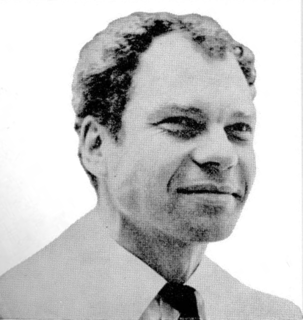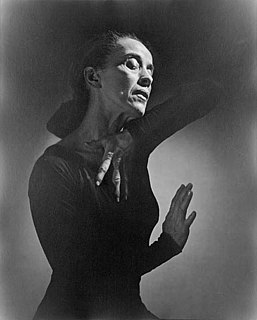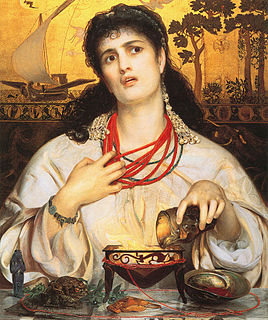Related Research Articles

Mercier Philip "Merce" Cunningham was an American dancer and choreographer who was at the forefront of American modern dance for more than 50 years. He frequently collaborated with artists of other disciplines, including musicians John Cage, David Tudor, Brian Eno, and graphic artists Robert Rauschenberg, Bruce Nauman, Andy Warhol, Roy Lichtenstein, Frank Stella, and Jasper Johns; and fashion designer Rei Kawakubo. Works that he produced with these artists had a profound impact on avant-garde art beyond the world of dance.

Mikhail Nikolayevich Baryshnikov is a Soviet Latvian-born Russian-American dancer, choreographer, and actor. He was the preeminent male classical dancer of the 1970s and 1980s. He subsequently became a noted dance director.

Martha Graham was an American modern dancer and choreographer. Her style, the Graham technique, reshaped American dance and is still taught worldwide.
Terese Capucilli, acclaimed interpreter of the roles originally performed by Martha Graham, is one of the last generation of dancers to be coached and directed by Graham herself. A principal dancer with the Martha Graham Dance Company for twenty-six years, she became associate artistic director in 1997 and from 2002 to 2005 served as artistic director, with Christine Dakin, seeing the organization and its dancers through the rebirth of the company. A torchbearer and driving force of Graham's work for nearly three decades, she is now Artistic Director Laureate.

Modern dance is a broad genre of western concert or theatrical dance which included dance styles such as ballet, folk, ethnic, religious, and social dancing; and primarily arose out of Europe and the United States in the late 19th and early 20th centuries. It was considered to have been developed as a rejection of, or rebellion against, classical ballet, and also a way to express social concerns like socioeconomic and cultural factors.

Jonah Bokaer is an American choreographer and media artist. He works on live performances in the United States and elsewhere, including choreography, digital media, cross-disciplinary collaborations, and social enterprise.

The Martha Graham Dance Company, founded in 1926, is known for being the oldest American dance company. Founded by Martha Graham as a contemporary dance company, it continued to perform pieces, revive classics, and train dancers even after Graham's death in 1991. The company is critically acclaimed in the artistic world and has been recognized as "one of the great dance companies of the world" by the New York Times and as "one of the seven wonders of the artistic universe" by the Washington Post.

Pam Tanowitz is an American dancer, choreographer, professor, and founder of the company, Pam Tanowitz Dance. She is a current staff member at Rutgers University's Mason Gross School of the Arts where she teaches dance and choreography. Her work has been performed at notable performance venues such as the Joyce Theater, the Joyce SoHo, and New York Live Arts, Kennedy Center for the Performing Arts.

La hija de Cólquide is a ballet score composed by Carlos Chávez in 1943–44 on commission from the Elizabeth Sprague Coolidge Foundation for Martha Graham. The title refers to the mythological character Medea, daughter of King Aeëtes of Colchis, in the story of Jason and the Golden Fleece. The ballet spawned several subsidiary works in Chávez's catalog including his Third String Quartet. When Graham eventually choreographed it, she wrote a new scenario and gave it the title Dark Meadow.

Every Soul Is a Circus is a comedic ballet choreographed by Martha Graham. The dance premiered on December 27, 1939, at the St. James Theatre in New York City. The original score was composed by Paul Nordoff. Philip Stapp created the set. Edythe Gilfond designed the costumes. The production marked the first appearance of Merce Cunningham with the Martha Graham Dance Company.
Primitive Mysteries is a modern dance work choreographed by Martha Graham to music by Louis Horst. Graham also designed the original costumes. The piece premiered on February 2, 1931 at the Craig Theatre in New York City. From the first performance, critics hailed the ballet as a masterpiece and acknowledged Graham's rising role as a major force in American dance.
American Document is a modern dance work choreographed by Martha Graham in response to rising Fascism in 1930s Europe. The piece premiered on August 6, 1938 at the Vermont State Armory in Bennington, Vermont. The ballet features spoken word excerpts from the Declaration of Independence and Emancipation Proclamation, among other texts. The set was created by Arch Lauterer; the costumes were designed by Edythe Gilfond. The original music was written by Ray Green. Graham extensively reworked the choreography in 1989. John Corigliano's Oboe Concerto replaced Green's music for the revised version.
Imagined Wing is a ballet choreographed by Martha Graham to Jeux de Printemps by composer Darius Milhaud. The piece was first presented on October 30, 1944, in the Elizabeth Sprague Coolidge Auditorium at the Library of Congress, Washington, D.C. Costumes were designed by Edythe Gilfond; the set was created by Isamu Noguchi. Elizabeth Sprague Coolidge commissioned the work, along with two other Graham dances, and musical scores for all three dances. Also on the program were Mirror Before Me set to music by Paul Hindemith and Appalachian Spring performed to music by Aaron Copland. Imagined Wing's initial showing was also its last. Following tepid reviews, the piece was never performed again.
Dolorosa is a modern dance solo choreographed by Martha Graham to music by Heitor Villa-Lobos. The work premiered on February 2, 1931, at New York's Craig Theatre. Dolorosa sometimes appeared in program notes with the subtitle from Primitive Cycle or from Primitive Cycle-Dance of Sorrow II.
Frontier is a solo dance choreographed by Martha Graham to music by Louis Horst. The set was designed by Isamu Noguchi; Graham created the costume. The work began as an ensemble piece, Perspectives: Frontier and Marching Song also known as Frontiers and Frontier. The ballet's Marching Song portion was set to music by Lehman Engle. The work premiered on April 28, 1935, at the Guild Theatre in New York City. By the end of 1935, Graham was performing Frontier exclusively as a solo. The piece was the first of her works to explore American identity through an archetypal character.
Horizons was a modern dance work choreographed by Martha Graham to music by Louis Horst with a set designed by Alexander Calder. It premiered on February 23, 1936, at the Guild Theatre in New York City. Horizons was divided into four parts, two ensemble dances and two solos: Migration: New Trails (ensemble), Dominion: Sanctified Power (solo), Building Motif: Homesteading (solo) and Dance of Rejoycing (ensemble). The ballet was performed by Martha Graham and Group, the predecessor of the Martha Graham Dance Company.
Vision of the Apocalypse was a modern dance created by Martha Graham to music by Hermann Reutter. It premiered on April 14, 1929, at the Booth Theatre in New York City. The occasion marked the debut of Martha Graham and Group, Graham's new concert ensemble and the predecessor to the Martha Graham Dance Company. Vision of the Apocalypse was the first piece Graham choreographed for a large group.
American Lyric was a modern dance work choreographed by Martha Graham to music of Alex North with costumes by Edythe Gilfond. The piece premiered on December 26, 1937, at the Guild Theatre in New York City. The ballet was subtitled Dance of Assembly. In some programs, the work also included the statement, "This dance has as its theme the basic American right—freedom of assembly."
Yuriko Kimura (木村百合子) is a modern dancer, and was a primary dancer for the Martha Graham Dance Company from 1967 to 1985. Various dance critics, such as Anna Kisselgoff and Clive Barnes from the New York Times, who often reviewed Yuriko's performances, referred to her dancing as "incandescent," and to Kimura as one of the "most outstanding performers in modern dance today" and "a brilliant technician for whom no movement seems impossible." She was born in Kanzawa, Japan.

Mark Walrod Harrington was an American scientist, the first civilian head of the United States Weather Bureau, and former president of the University of Washington. Considered a prominent scientist in the late 19th century, Harrington studied and published works in multiple disciplines, including botany, astronomy, meteorology, and geology, and knew a half-dozen languages. His academic achievements were overshadowed by his disappearance in 1899, when he left home one day and disappeared for many years. His wife and son located him in 1908 at a psychiatric hospital in New Jersey where he had been admitted as patient John Doe No. 8.
References
- 1 2 3 4 "El Penitente (Ballet choreographed by Martha Graham)". Library of Congress, Washington, D.C. 20540 USA. Retrieved 2022-07-21.
- 1 2 "Martha Graham and Company Open Week of Repertory at National". Library of Congress, Washington, D.C. 20540 USA. Retrieved 2022-07-21.
- ↑ "Martha Graham In Concert Here Monday". Library of Congress, Washington, D.C. 20540 USA. Retrieved 2022-07-21.
- 1 2 "The Dance". Library of Congress, Washington, D.C. 20540 USA. Retrieved 2022-07-21.
- ↑ Jack Anderson, The American Dance Festival, Duke University Press, 1987, p. 98
- ↑ "Now, About Martha Graham". Library of Congress, Washington, D.C. 20540 USA. Retrieved 2022-07-21.
- 1 2 "Miss Graham At Mansfield in Dance Recital". Library of Congress, Washington, D.C. 20540 USA. Retrieved 2022-07-21.
- ↑ Martha Graham Dance Company press kit, 2013 http://www.shaganarts.com/images/MGDCpresskit2013%20(no%20prices).pdf
- ↑ Anderson, Jack (1989-10-10). "Review/Dance; Penitence and Temptation In a Martha Graham Work". The New York Times. ISSN 0362-4331 . Retrieved 2022-07-21.
- ↑ Deborah Jowitt, Time and the Dancing Image, University of California Press, 1989, p. 207
- ↑ "Martha Graham Gives New Works--"Letter to the world" and "El Penitente" Are Danced at Mansfield Theatre". Library of Congress, Washington, D.C. 20540 USA. Retrieved 2022-07-21.
- ↑ "Martha Graham & Group, Jan. 20, Mansfield Theatre, New York". Library of Congress, Washington, D.C. 20540 USA. Retrieved 2022-07-21.
- ↑ "Miss Graham Gives a New Dance Work". Library of Congress, Washington, D.C. 20540 USA. Retrieved 2022-07-21.
- ↑ "Dance: '64 American Festival Closes; Memorial Program Is Homage to Horst". The New York Times. 1964-08-17. ISSN 0362-4331 . Retrieved 2022-07-21.
- ↑ Marcia B. Siegel, Are Graham's Gods Dead?, New York Magazine, June 24, 1968, p. 54
- 1 2 Dunning, Jennifer (1986-06-05). "DANCE: 'EL PENITENTE,' BY GRAHAM". The New York Times. ISSN 0362-4331 . Retrieved 2022-07-21.
- ↑ Tobi Tobias, Dance, Passing Fancies,New York Magazine, Oct 24, 1988, p.118
- ↑ "A poet's mind takes flight in movement. Martha Graham revivals were paradoxically dimmed by star power". Christian Science Monitor. 1988-10-26. ISSN 0882-7729 . Retrieved 2022-07-21.
- ↑ Donna Perlmutter, Baryshnikov Steps Modernly Tonight, Los Angeles Times, October 28, 1991 http://articles.latimes.com/1991-10-28/entertainment/ca-368_1_white-oak-dance-project